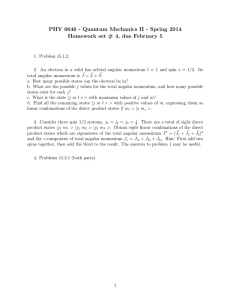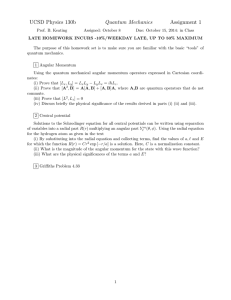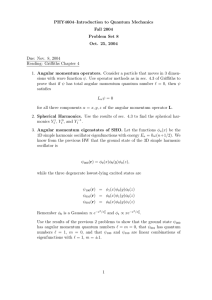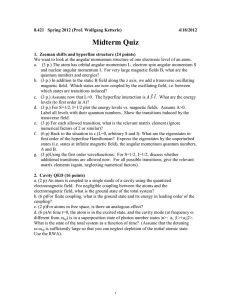Atomic Transitions
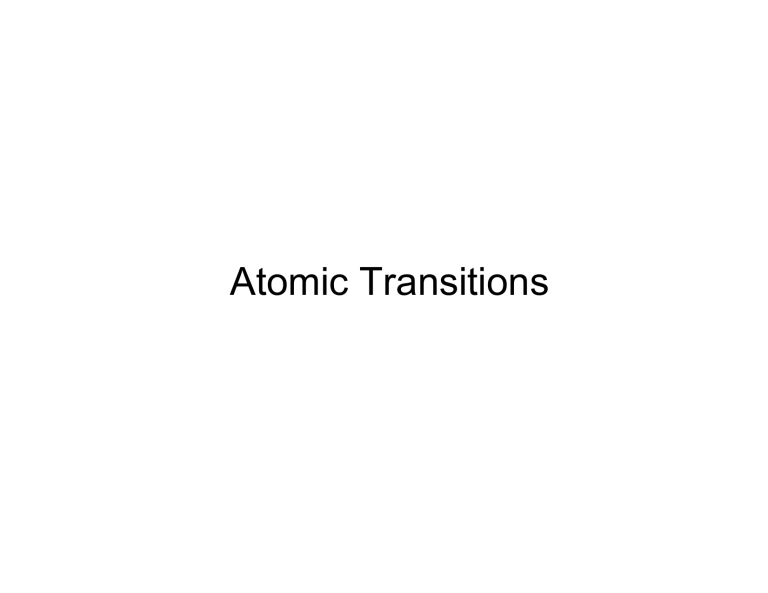
Atomic Transitions
Transitions between atomic states
(Hydrogen Atom)
• Transition probabilities are different depending on the combination of the quantum numbers (n, l ,m l
,m s
) of the initial and final states
• Selection rules:
– Δ n = anything
–
Δ l = ±1
– Δ m l
= 0, ±1
• The photon carries one unit of angular momentum ( ħ )
Allowed / Forbidden transitions
• Allowed transitions:
– Electrons absorbing or emitting photons to change states when Δℓ = ±1.
• Forbidden transitions:
– Other transitions still possible (not truly forbidden) but occur with much smaller probabilities when Δℓ ≠ ±1
Total Angular Momentum
• Solving the Schödinger equation introduces the orbital angular momentum as quantum number.
• A relativistic treatment would also yield the spin angular momentum as quantum number
Orbital angular momentum Spin angular momentum
Total angular momentum
Total angular Momentum
• If j and m j atom).
are quantum numbers for the single electron (hydrogen
• Quantization of the magnitudes.
• The total angular momentum quantum number for the single electron can only have the values
L , L z
, S , S z
J and J z
are quantized.
Quantum Numbers
• New quantum numbers:
– j = l ± s
Total angular momentum quantum number j=+1/2 (if l =0)
– -j ≤ m j
≤ j j, m j
: half-integers
• Notation:
– (nlm l
) changed to: (nLm j
– Example:
)
• n=2, l =1, m j
=3/2 gives 2P
3/2
Precession
• Only J z
can be known because the uncertainty principle forbids J x
or J y
from being known at the same time as J z
.
No external magnetic field
Random Orientation
External Magnetic field
J cannot align with B ext
(also true for L and S )
Complex precession motion
Spin-Orbit Coupling
• An effect of the spins of the electron and the orbital angular momentum interaction is called spin-orbit coupling .
• Similarly than in the case of the magnetic moment:
– Spin magnetic moment ∝
–
• Level splitting due to spin-orbit coupling:
– j = l - ½ lower in energy than j = l + ½
2P
2P
3/2
2P
1/2
(4) -3/2 ≤ m j
≤ 3/2; m j
= ±1/2, ±3/2
(2) -1/2 ≤ m j
≤ 1/2; m j
= ±1/2
Expanded selection rule
• Now the selection rules for a single-electron atom become
– Δ n = anything
– Δ m j
= 0, ±1
Δℓ = ±1
Δ j = 0, ±1
Many-electron atoms?
Two-electron atom:
It gets messy very quickly!
Couplings: LS, jj
Hund’s rules (1925):
• The total spin angular momentum S should be maximized to the extent possible without violating the Pauli exclusion principle.
• Insofar as rule 1 is not violated, L should also be maximized.
• For atoms having subshells less than half full, J should be minimized.
Simplification?
• For example:
– Alkalis: core + one electron
– Similar to H
